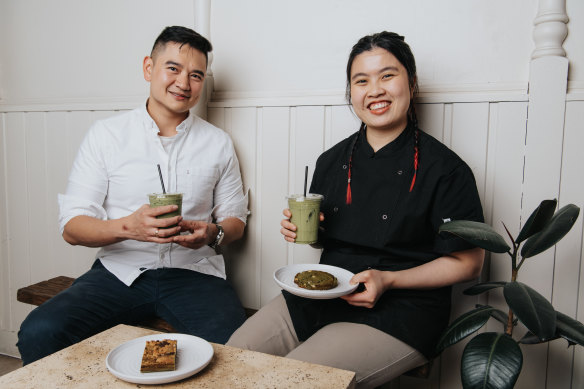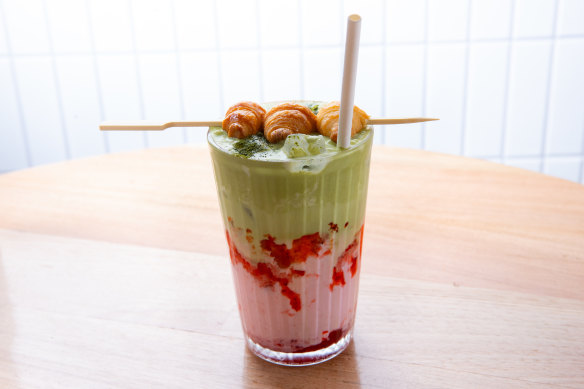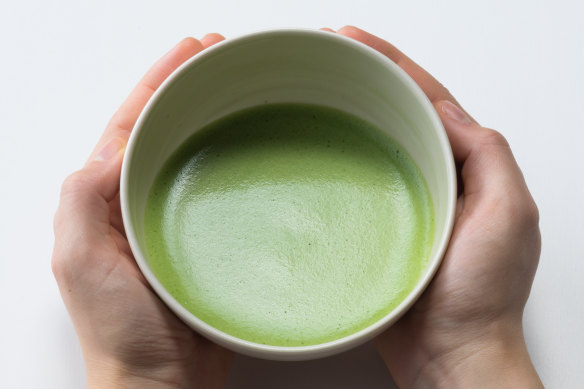Matcha limits set and prices set to soar as global shortage hits Australia
It’s turning up in everything from lattes and smoothies to pastries. Here’s why the world has gone mad for matcha and why the price is set to spike.
It’s lean, it’s green and it’s taking over Australian cafe cuisine. Matcha, a powdered green tea promising a smooth caffeine hit and numerous health benefits, has become a global sensation, outselling coffee at many cafes, going viral on social media and for the first time depleting stocks at centuries-old Japanese producers.
At Stanmore bakery-cafe Pantry Story, which opened in February, customers queue along Parramatta Road for croissants filled with creamy, matcha-infused frangipane, and iced coconut water layered with a thick matcha foam.

Co-owners Mutiara Putri Sucipto and Hari Wibowo say every time they introduce a new matcha item to the menu, it becomes a bestseller.
At Melbourne cafe Bloomwood, customers need to get in line for the strawberry matcha “Bloomtini”, its signature iced drink made with hand-whisked matcha and milk, layered over strawberry foam, and garnished with three tiny croissants on a cocktail pick.
Co-owners Darren Nguyen, Brian Taing and Joe La are espresso enthusiasts who found it “remarkable” when matcha sales began to rival coffee sales, but they’re not alone.

Matcha has become the go-to drink at cafes across the country, including Naau Cafe (Melbourne), where it makes up to 80 per cent of all sales.
“I really feel like it could become as popular as coffee,” says Taka Kaneko, owner of Edo Matcha, a tea shop in Newtown. Kaneko has struggled to keep up with demand, often waiting up to three months for a new shipment to arrive from Japan.
The surge in popularity over the past three to six months has led renowned Japanese tea manufacturers such as Ippodo Tea, Marukyu Koyamaen and Horii Shichimeien to slow and eventually restrict the supply of matcha.
“Few, if any, predicted the rapid increase in matcha’s popularity,” says Axel Snow, a representative of Kyoto’s Ippodo Tea Co.
“There is only one high-quality harvest in this region each year, and grinding these leaves into matcha powder takes time. For the time being, we’ve decided to limit the varieties and quantities available to maintain our strict quality standards.”

The shortage has started to affect Australian retailers and cafes, including Surry Hills tea shop Simply Native. This week, it announced limits on online purchasing.
“Several suppliers have told us they’re pausing production and putting a stop on any future orders,” says manager Megumi Kanaike.
Claims of a shortage are disputed by Maria Mooney, the Sydney-based director of Grow Green Tea Company and Matcha Matcha, a wholesale supplier and retailer of green tea and matcha grown on family-owned farms in Shizuoka, Japan.
“There is no shortage of matcha production not only across our farms, but our contracted farms across Japan,” Mooney says.
As demand rises, so does the price. Kanaike says Kyoto-based producers of the highest-quality matcha recently increased prices by up to 40 per cent, the first price hike in many years. “You’ll probably notice prices in cafes start to go up as well,” she says.
In Sydney, the drink’s popularity led to the creation of Matcha Club, a monthly social gathering combining activities such as Pilates and picnics with matcha.
“Sydney has a huge matcha scene that continues to grow and gain popularity, so a matcha club seemed like an interesting and unique way to connect with new people and make new friends,” said sisters Ellene and Donna Win, who co-founded the club in June.

What is matcha, anyway?
Japanese matcha is a fine powder made from the young, bright green leaves of the Camellia sinensis plant. The plants are traditionally grown under shade and harvested once a year. The leaves, known as tencha, are rich in antioxidants and lower in bitterness than their loose-leaf counterparts (sencha).
To make matcha, the whole leaves are steamed, dried, destemmed and ground on a millstone, a laborious, centuries-old process that must be done slowly to avoid warming and altering the aroma of the leaves.
High-quality matcha is traditionally served as a thick tea, whisked with water in a stone bowl. In Australian cafes, it’s most commonly served as a hot or iced matcha latte, whisked with milk.
What does it taste like?
“Producers try to balance the flavours of umami, bitterness, sweetness, and the fragrance,” says Kanaike. “Every matcha is different, but what makes a good matcha is balance, and that vibrant green colour.”
There are several grades of matcha, from the cheaper culinary variety (mostly used in baking) to the most expensive grade, once reserved for traditional tea ceremonies and Buddhist temples. The traditional methods used to make ceremonial-grade matcha result in a soft, powdery product, deep green in colour, with a gentle sweetness.
Why is it so popular?
According to retailers and cafe owners, there are two key reasons for the matcha boom: it looks good on social media, and its proponents claim it is a healthier source of caffeine.
“In a social media-driven world where aesthetic food and drinks gain attention, matcha has thrived as a visually striking option,” says Joanne Zhang, owner of Melbourne’s Fuumi Fuumi bakery cafes, where matcha sales have outpaced traditional cafe beverages.
“[It’s] a coffee substitute but with more overall health benefits,” says Bloomwood’s Darren Nguyen. “It contains caffeine to give you the energy boost you need, without the side effects, and contains antioxidants [which] can improve one’s wellbeing.”
Is it actually good for me?
Because of the way it’s grown and processed, matcha has a higher concentration of nutrients than loose-leaf green tea. And while there’s no definitive proof about the health claims around matcha, it does contain beneficial antioxidants (linked to the protection of cells), the amino acid L-theanine (which shows early signs of improving cognitive performance and reducing stress) and caffeine (which can increase mental alertness and metabolism).
